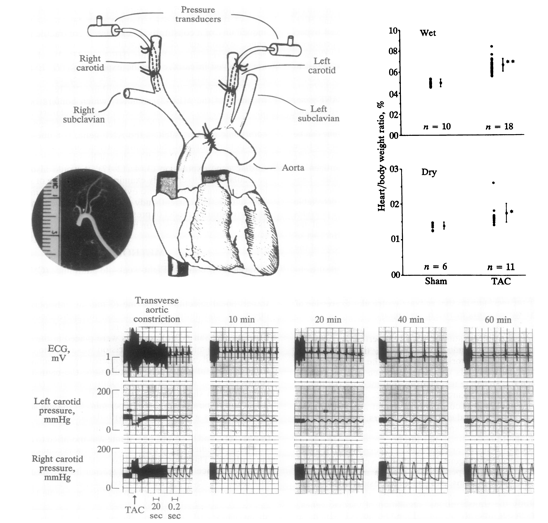Introduction: TAC is the most common disease model for chronic ventricular hypertrophy, which can be used to simulate hypertrophic cardiomyopathy caused by hypertension or increased intraventricular pressure. Furthermore, it has been widely used in preclinical drug research, basic medicine, and biological research. The process of ventricular hypertrophy induced by TAC surgery varies across mouse strains and the stenosis degree (27G stenosis, 28G stenosis). In general, after 1 week (28G stenosis) or 2 weeks (27G stenosis), significant ventricular hypertrophy may occur; after 2 to 3 weeks (28G stenosis) or 4 to 6 weeks (27G stenosis), heart failure may occur.
Animal requirement: Rats and mice, males are preferable. In special cases, female animals may be used. Age and weight can be adjusted accordingly.
Brief Protocol:
- Male mice are preferable.
- Age from 9~10 weeks.
- Stenosis degree: moderate stenosis (27G) or severe stenosis (28G).
- Precise quantitative stenosis is achieved by wire ligation of transverse aorta, to limit the blood flow and increase the indoor pressure.
- The Introduction of TAC-induced ventricular hypertrophy or heart failure was first established by Rockman in 1991, and later became a widely used model of ventricular hypertrophy and heart failure.
 Transverse Aortic Constriction (TAC) and heart weight ratio, hemodynamic parameter changes, refer to PNAS. 1991; 88(18):8277-81.
Transverse Aortic Constriction (TAC) and heart weight ratio, hemodynamic parameter changes, refer to PNAS. 1991; 88(18):8277-81. Turnaround time:
Acute and chronic experiments can be performed. Postoperative time ranges from a few hours to several weeks (heart failure model).
Pre/Post-operative management and delivery:
The whole process, including the breeding, surgery and post-operative management is carried out in Cyagen AAALAC-accredited SPF-level breeding facility.
Before the surgery, animals can be supplied by customers. Alternatively, Cyagen can help purchase Bio-standard animals (C57 mice, Wistar rats, or any commercially available GEMs worldwide). After full recovery from surgery, disease models can be delivered to customers by dedicated express.
Follow-up service:
- After-surgery routine observation: daily activities and diet intake are observed by full-time veterinarians, and pain relief treatment is applied accordingly.
- Cardiac ultrasonography: comprehensive evaluation of cardiac structure and function is achieved by ultra-high-definition small-animal-specific ultrasound machine. The evaluation of cardiac function before and after surgery (different periods of ventricular hypertrophy or heart failure development) includes the wall thickness (IVSs, IVSd, LVPWs, LVPWd), ventricular volume (LV Vols, LV Vold), ventricular lumen diameter (LVIDs, LVIDd), ejection fraction (EF%), fractional shortening (FS%) etc. Customized ultrasonic tests can be performed upon request.
- Post-operative electrocardiogram detection: ECG records analysis at multiple time points.
- Blood sample collection: 0.7-1.0 mL venous blood, collected from adult mice or rats according to weight, can be used for various biochemical tests. The serum or plasma is stored in a -80⁰C refrigerator until delivery or biochemical detection.
- Cardiopulmonary specimen collection: Cardiopulmonary specimens are collected from different sections. The heart and lung specimens can be used to calculate the heart weight to body weight ratio and lung weight to body weight ratio. Besides, the specimens can be stored in a -80⁰C refrigerator or fixed with formalin for further pathological examination.
Animal ethical censorship and management
The Institutional Animal Care and Use Committee (IACUC) reviews the experimental protocol and manages the entire surgical procedure, including anesthesia, analgesia, animal preparation, and post-operative management.
Contact us:
For any surgical disease model, the strategy can be adjusted according to the scientific problems that researchers want to solve. If you have any special requests, please contact 86 20-31601779 or email apac-service@cyagen.com. Cyagen provides surgical model services personalized for your research goals - our senior technical team will develop a detailed experimental plan according to your needs and keep you updated throughout the model generation process.
References:
- Rockman HA, Ross RS, Harris AN, Knowlton KU, Steinhelper ME, Field LJ, Ross J, Chien KR. Segregation of atrial-specific and inducible expression of an atrial natriuretic factor transgene in an in vivo murine model of cardiac hypertrophy. PNAS. 1991; 88(18):8277-81.
- Rongli Zhang, Douglas T. Hess, James R. Reynolds, Jonathan S. Stamler. Hemoglobin S-nitrosylation plays an essential role in cardioprotection. Journal of Clinical Investigation, 2016; 126(12): 4654-4658.
- Priti Anand, Jonathan D. Brown, Charles Y. Lin, Jun Qi, Rongli Zhang, Pedro Calderon Artero, M. Amer Alaiti, Jace Bullard, Kareem Alazem, Kenneth B. Margulies, Thomas P. Coppola, Madeleine Lemieux, Jorge Plutzky, James E. Bradner, Saptarsi M. Haldar. BET bromodomains mediate transcriptional pause release in heart failure. Cell, 2013, 154, 569-582.
- Hiroki Hayashi, Douglas T. Hess, Rongli Zhang, Keiki Sugi, Huiyun Gao, Bea L. Tan, Dawn E. Bowles, Carmelo A. Milano, Mukesh K. Jain, Walter J. Koch, Jonathan S. Stamler. S-Nitrosylation of β-Arrestins Biases Receptor Signaling and Confers Ligand Independence. Molecular Cell, 2018, 70, 473-487.
- Rongli Zhang, Yuyan Shen, Lin Zhou, Panjamaporn Sangwung, Hisashi Fujioka, Lilei Zhang, Xudong Liao. Short-term administration of Nicotinamide Mononucleotide preserves cardiac mitochondrial homeostasis and prevents heart failure. Journal of Molecular and Cellular Cardiology, 2017, 112: 64-73. doi:10.1016/j.yjmcc.2017.09.001
- Xudong Liao, Rongli Zhang, Yuan Lu, Domenick A Prosdocimo, Panjamaporn Sangwung, Lilei Zhang, Guangjin Zhou, Puneet Anand, Ling Lai, Teresa C Leone, Hisashi Fujioka, Fang Ye, Mariana G Rosca, Charles L Hoppel, P Christian Schulze, E Dale Abel, Jonathan S Stamler, Daniel P Kelly, Mukesh K Jain. Kruppel-like factor 4 is critical for transcriptional control of cardiac mitochondrial homeostasis. Journal of Clinical Investigation, 2015;125(9):3461-3476. doi:10.1172/JCI79964.


 Transverse Aortic Constriction (TAC) and heart weight ratio, hemodynamic parameter changes, refer to PNAS. 1991; 88(18):8277-81.
Transverse Aortic Constriction (TAC) and heart weight ratio, hemodynamic parameter changes, refer to PNAS. 1991; 88(18):8277-81.